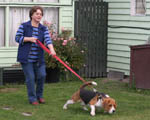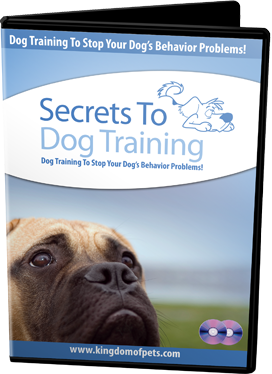 On any animal bloopers or funniest home video show, you are likely to find some sort of slapstick scene of a dog pulling on a lead. Often this will involve a very large dog and a very small owner. In the last one I saw, there was a family on a camping holiday that tied their dog to their tent. It saw something it wanted to chase. Enough said.
On any animal bloopers or funniest home video show, you are likely to find some sort of slapstick scene of a dog pulling on a lead. Often this will involve a very large dog and a very small owner. In the last one I saw, there was a family on a camping holiday that tied their dog to their tent. It saw something it wanted to chase. Enough said.
Dogs pull on leads as a matter of instinct. As hunting animals, they live for the chase. So often they pull because they are in pursuit of something (a cat, squirrel, or another dog). But there are other reasons that are just as common. It's possible that they are uncontrollably over-excited about their daily session of quasi-freedom. And it is possible that they see themselves as the dominant animal in your family. In this case, they see you as the one who is being disobediently slow.
Whatever the reason, the traditional method of addressing the issue of pulling on the lead is more or less the same. It involves a series of repeated interventions whereby:
1) The dog pulls on the lead
2) you stop,
3) issue a sharp verbal command ("uh uh"),
4) and a quick tug back on the lead.
5) You start walking again.
6) Repeat.
This training technique works eventually, provided there is enough repetition. But in the short term, your walks are not likely to be very long at all!
Another "traditional" solution to this problem is the use of choke chains and collars, a method that, thankfully, is now deemed to be unnecessary and outdated in the professional dog training community.
There are some innovative training techniques around to address the leash pulling problem. One that comes to mind in particular is the "random walking" method demonstrated by professional trainer Susan Morton in our Kingdom of Pets Dog Training DVD Series. The concept is brilliantly simple: a dominant or over-anxious dog can't pull on the lead if he doesn't know which direction he's heading, and if that direction changes often. You'll have to check out the DVD to find out exactly how to make it work for you.
There is more good news for dog owners who are tired of their dogs yanking their chain, so to speak. Leash and collar technology has advanced enough to offer dog owners a few alternatives to solutions to the pulling problem: head and harness collars.
When I started training dogs, head or "harness" collars were new on the market and all the rage. Premier Pet Gentle Leader Training Dog Collar® and the Halti Training Head Collar® are the two best known types of dog head collars, and are often discussed interchangeably even though there are slight differences in the design and they are made by different companies. Because I have used the Gentle Leader® extensively, though not exclusively, in my own experience, I will focus on it.
What is it? As opposed to traditional dog collars that go around the neck, the Gentle Leader® is a head harness that consists of a nylon nose strap and neck strap. The lead is attached to a ring at the end of a short strap that extends under the chin.
How does it work? Both straps are designed to have a specific function. The nose loop is intended to mimic the practice of demonstrating pack dominance between two animals by firmly taking a dog's muzzle in their own. The neck strap is intended to relax and calm the dog by mimicking the practice of a mother grasping her pups by the back of the neck. In addition, the strap applies pressure to the back of the neck instead of the front of the throat.
Dogs tend to respond to an applied force by exerting an opposing force, which is why they often respond to a backwards pull of lead with more pulling! The Gentle Leader® is designed to reverse this behavior, and arrest forward movement when force is exerted on the neck.
Most importantly, the lead allows the owner to control the head of the dog, and - not unlike a horse's bridle - if you control the head you control the beast.
How effective is it? In my experience the Gentle Leader® is extremely effective in correcting pulling, lunging, and jumping. I found it particularly effective with owners who like to run with their dogs, but need to keep them in line on populated paths and trails. It can be used to facilitate the basic obedience commands such as "sit" and "down."
Although the product information notes that the collar will stop unwanted barking (through a quick tug of the lead that closes the dog's mouth), I found the lead less effective in this regard.
Perhaps the best thing about this form of lead is that you are constantly training the dog without the need for constant commands. In addition, you are reinforcing your role as the leader. You stop, they stop, simple as that.
In the majority cases, owners who start with the Gentle Leader® from an early age wind up going back to a straight lead after several months - or even have their dog comfortably off lead when they are able to. That's important, as it demonstrates how effective it can be as a training tool.
That's all from us for part 4 of your Secrets to Dog Training 6 Day Course. I truly hope that by sharing this information I have helped put the pulling problem to rest, and saved your dog-walking arm in the process!
Join me next time when we'll be getting tough on one of the most problematic behaviors a dog can have: aggression toward strangers and other dogs.
Until then,
![]()
Daniel Stevens
Secrets to Dog Training
http://www.kingdomofpets.com/dogobediencetraining/
 I've been a professional dog trainer for well over 20 years, and in that time I've helped thousands of dog owners just like you to get the friendly, well behaved, slipper fetching, best pal they always wanted.
I've been a professional dog trainer for well over 20 years, and in that time I've helped thousands of dog owners just like you to get the friendly, well behaved, slipper fetching, best pal they always wanted.
But it didn't start out that way. I've always loved dogs, some things never change. But when I first started my professional dog training career I relied on the so-called 'best practices' when it came to dog behavior training. It was only when I heard people tell me over and over again that they just weren't seeing results that I started to question the old accepted wisdom. So I started a journey, a quest to search out the best, most effective, techniques, tips, and tricks that really work.
And that's how I came up with Secrets to Dog Training. Year after year I found new techniques that achieved the results I wanted. Eventually I had a whole book worth of great resources: Secrets to Dog training...
So, if you want to:
Then Secrets to Dog Training is just what you've been looking for!
Previous Newsletters